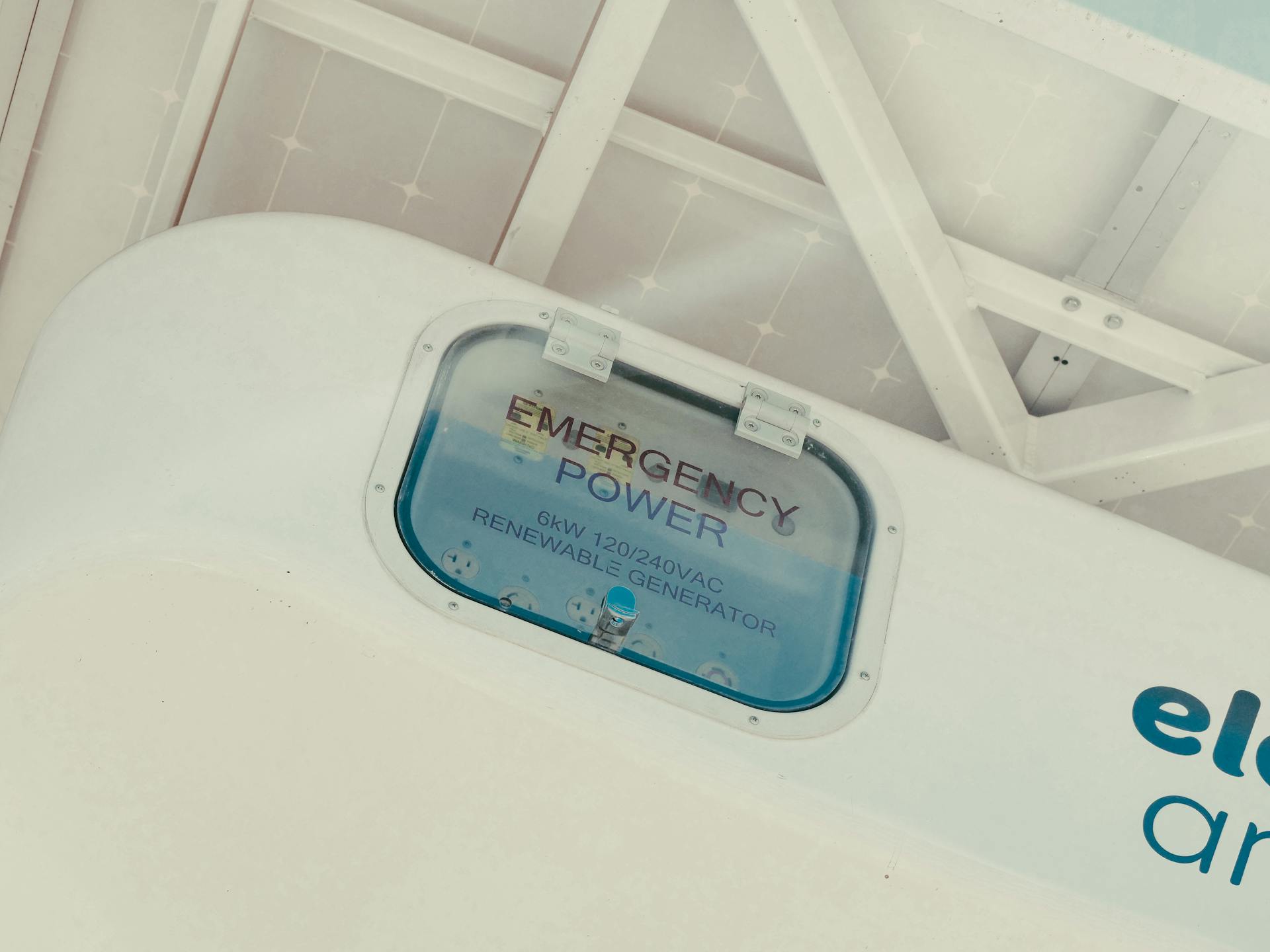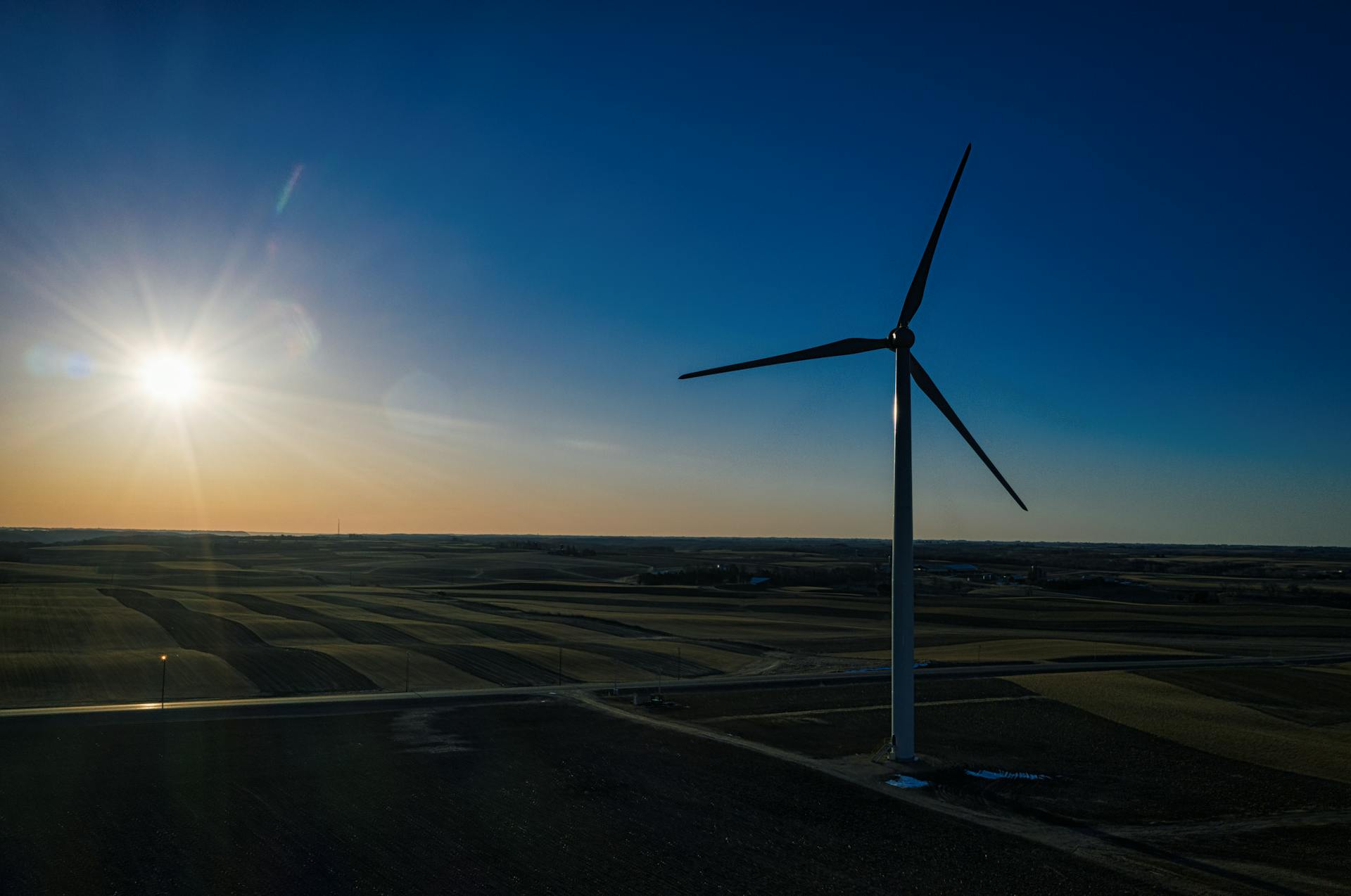
Portable generators are a lifesaver during power outages or camping trips. They're essentially a compact power plant that can provide electricity on the go.
The heart of a portable generator is the engine, which can be gasoline, diesel, or propane-powered. This engine drives an alternator, which converts mechanical energy into electrical energy.
The alternator is the key component that produces the electricity we need. It's essentially a magnetic coil that generates a magnetic field, which induces an electric current in the windings.
The generated electricity is then sent to the control panel, where it's regulated and conditioned to ensure it's safe for use.
For more insights, see: Dc Generator vs Alternator
Generator Components
A portable generator is made up of several key components that work together to produce electricity. The engine supplies the energy to the generator, with the power of the engine determining how much electricity it can provide.
The alternator is where the conversion from mechanical energy to electrical energy occurs. It contains moving and stationary parts that work together to create the electromagnetic field and movement of electrons that generates electricity. This is also known as the "genhead".
The fuel system is responsible for producing the energy needed to power the generator. It includes a fuel tank, a fuel pump, a pipe connecting the tank to the engine, and a return pipe. A fuel filter removes debris before it gets to the engine, and an injector forces the fuel into the combustion chamber.
A generator's cooling and exhaust systems are crucial for its operation. The cooling system prevents the machine from overheating, while the exhaust system directs and removes the fumes that form during operation.
Here are the main components of a generator:
- Engine
- Alternator
- Fuel System
- Cooling and Exhaust Systems
- Voltage Regulator
- Battery Charger
- Control Panel
- Main Assembly / Frame
The fumes emitted by generators are similar to the exhaust given off by other gas or diesel powered engines, containing toxic chemicals like carbon dioxide that must be filtered and removed from emissions.
The rotating shaft connects to the engine motor or propellers in wind/water generators and spins the armature inside the stator. The stator is a stationary magnetic field with large copper windings. The armature creates electromagnetic induction by spinning inside the stator of opposing magnetism.
How a Portable Generator Works
A portable generator works by converting fuel, such as gasoline, propane, or diesel, into electrical power. This process relies on the internal combustion engine, which drives a generator, a set of coiled copper wires surrounded by magnets.
The engine spins the magnets, causing a current to be induced in the copper wires, which in turn produces electric power. This electric power is regulated using a voltage regulator and then passed through an outlet of the generator to be used by appliances.
The generator's internal combustion engine is connected to the alternator, which is where the conversion from mechanical energy to electrical energy occurs. The alternator contains both moving and stationary parts that work together to create the electromagnetic field and movement of electrons that generates electricity.
Here are the five primary parts of a portable generator:
- Internal combustion engine
- Alternator
- Starter
- Fuel tank
- Outlets
A Portable Generator
A portable generator is a compact device that can provide power to your home or RV, and it's essential to understand how it works.
These generators run on fuel such as gasoline, propane, or diesel, which is converted into electrical power.
A portable generator's internal combustion engine drives a generator, which is a set of coiled copper wires surrounded by magnets.
The engine's spinning magnets cause a current to be induced in the copper wires, producing electric power.
This electric power is regulated using a voltage regulator, ensuring a stable output.
The regulated power is then passed through an outlet of the generator to be used by appliances.
Portable generators can be quieter and lighter than equally powerful generators, making them a convenient option for outdoor use.
Some portable generators, like the Champion model, can run on gas or propane for up to 17 hours, providing a reliable power source.
However, it's crucial to use a well-known generator brand, particularly those belonging to the Portable Generator Manufacturers Association, to ensure quality power output.
Readers also liked: Direct Current Electric Generator
How a Generator Works
A portable generator works by converting fuel, such as gasoline, propane, or diesel, into electrical power. The generator's internal combustion engine drives a generator, which is a set of coiled copper wires surrounded by magnets. When the engine spins the magnets, it causes a current to be induced in the copper wires, which in turn produces electric power.
The five primary parts of a portable generator include an internal combustion engine, an alternator, a starter, a fuel tank, and outlets. The alternator is where the conversion from mechanical energy to electrical energy occurs. It contains both moving and stationary parts that work together to create the electromagnetic field and movement of electrons that generates electricity.
The power of the engine determines how much electricity a generator can provide. A portable generator's internal combustion engine drives the alternator, which is a set of coiled copper wires surrounded by magnets. The engine spins the magnets, causing a current to be induced in the copper wires, producing electric power.
The electric power is regulated using a voltage regulator and then passed through an outlet of the generator to be used by appliances. Generators create a lot of heat, and the cooling system ensures the machine doesn’t overheat. The exhaust system directs and removes the fumes that form during operation.
Here are the key components of a generator:
- Frame: Shields electrical and moving parts, keeps dirt and moisture out.
- Rotating Shaft: Connects to the engine motor or propellers in wind/water generators and spins the armature inside the stator.
- Stator: A stationary magnetic field with large copper windings.
- Armature: Creates electromagnetic induction by spinning inside the stator of opposing magnetism.
- Bearings: Reduce friction caused by the rotation.
- Field Windings: A coil that creates a magnetic field through which current flows.
- Commutator: A conductor through which electricity collects.
- Brush Assembly: Rubs against the commutator that sends electrical current out.
Inverter Generators
Inverter generators are the kind you've most likely seen used for camping and outdoor recreation. They're a popular choice for powering small appliances and devices.
Inverter generators generate AC electricity, which is the type of electricity used by most household devices. This makes them suitable for powering things like smartphones, lights, radios, fans, and heaters.
One of the benefits of inverter generators is that they can store DC power. This allows them to provide a stable source of electricity, even when the load is high.
Inverter generators are portable, making them easy to take on the go. They're a great option for camping trips, tailgating, or other outdoor activities.
Expand your knowledge: Portable Camping Generators
Generator Requirements and Setup
To get a portable generator up and running, you'll need to consider a few key requirements. The most important one is the power output, which should match the appliances you plan to power.
A typical portable generator can produce between 1,000 to 10,000 watts of power, depending on the model.
For a safe and efficient setup, choose a generator with a fuel type that suits your needs, such as gasoline, propane, or natural gas.
Generator Control Panel and ATS
The generator control panel is the brain of the generator and the user interface, where you'll access and control generator operation. It's a crucial component that makes modern-day generators tick.
The control panel often features an Automatic Transfer Switch (ATS), which continuously monitors incoming power. When the power level drops or cuts out entirely, the ATS signals the control panel to start up the generator.
Engine gauges on the control panel provide important information about oil and fluid levels, battery voltage, engine speed, and operational hours. This information helps site managers stay on top of generator maintenance and catch potential issues before they become major problems.
Generator gauges provide valuable information about output current, voltage, and operating frequency. This data is essential for monitoring the generator's performance and making adjustments as needed.
Regular maintenance is key to extending the life of your generator. This includes tasks such as checking fluid levels, inspecting and cleaning the battery, and conducting load bank tests on the generator and ATS. It's also essential to maintain a maintenance log for recordkeeping, including readings, fluid levels, and date and hour meter readings.
For your interest: Inverter Battery Generator
Here are some key maintenance tasks to consider:
- Checking of fluid levels, including coolant and fuel
- Inspection and cleaning of the battery
- Conducting of a load bank test on the generator and automatic transfer switch
- Checking of the control panel to ensure accuracy of readings and indicators
- Changing of the air and fuel filters
- Inspection of the cooling system
- Lubrication of parts as needed
By following these simple maintenance tasks and keeping a maintenance log, you can help your generator last for decades and avoid costly repairs or even full genset replacement.
Generator Fuel Requirements
Generator fuel requirements can be a bit confusing, but it's actually quite straightforward.
Diesel generators are the most popular choice for industrial use.
They're widely available and often preferred for their reliability and efficiency.
Residential generators, on the other hand, usually run on natural gas or propane.
These fuels are cleaner-burning and often less expensive than diesel.
If you're looking for a smaller, portable generator, you'll likely find options that run on gasoline, diesel fuel, or propane.
Some of these units are even bi-fuel capable, meaning they can switch between gasoline and diesel.
It's essential to check your generator's manual for specific fuel recommendations, as the best fuel for your generator will depend on its make and model.
Electrical Requirements
To run a generator safely and efficiently, you'll need to consider the electrical requirements of your setup. The type of generator you choose will determine the electrical requirements, with most generators producing between 2,000 and 12,000 watts of power.
A 30-amp circuit is typically sufficient for a small to medium-sized generator, but a 50-amp circuit may be needed for larger units. This is because larger generators require more power to operate safely.
You'll also need to consider the voltage of your generator, which should match the voltage of your electrical panel. Most homes in the US have a 240-volt electrical panel, but some may have 120-volt panels.
It's essential to choose a generator with a sufficient starting capacity to handle the electrical requirements of your appliances. A typical air conditioner requires around 15-20 amps to start, while a refrigerator requires around 5-7 amps.
A 30-amp circuit can handle up to 3,000 watts of power, but it's recommended to leave at least 20% of the circuit's capacity free to avoid overloading the generator.
For your interest: How Many Watt Generator to Run Ac
Test Run
A test run is crucial to ensure your portable generator operates properly.
You should run a full test on your generator as soon as it's set up, before you need it for an emergency.
This will help you identify any potential issues before they become major problems.
During the test run, pay attention to whether everything operates smoothly on generated power as it does on utility power.
If you notice any problems, check the connections and wiring to ensure they're secure and not damaged.
Featured Images: pexels.com


